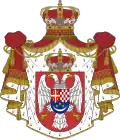| Organisation of African Unity | Yugoslavia |
|---|---|
During the Cold War period former Southeast European country of the Socialist Federal Republic of Yugoslavia established and maintained significant political, cultural and economic exchanges and relations with newly independent African states. While majority of multilateral exchanges were organized via Non-Aligned Movement and the United Nations, significant cooperation developed with the Organisation of African Unity as well, predecessor to contemporary African Union. Yugoslavia was the only non-African country which participated in funding of the Liberation Committee of the Organisation of African Unity.[1][2] While being a uniquely involved in the workings of the body the country nevertheless preferred bilateral relations with individual liberation movements.[3] The Organisation of African Unity included the Non-Alignment principle in its charter while Yugoslavia consider the organisation to be the only legitimate representative for the entire African continent throughout the Cold War era.[4] Yugoslavia therefore followed common OAU line in its own policies towards issues in Africa.[4]
Context
Yugoslavia, contrary to many Western Bloc countries in Europe did not have any direct colonial past which complicated relations between former Metropoles and newly independent states. The country believed that its own historical experiences of foreign domination by Austro-Hungarian and Ottoman empire, challenges in development and complex multi-ethnic federalist structure are akin to experiences of newly independent post-colonial countries in Africa. At the same time, from the 1948 Tito–Stalin split onwards the country was not anymore under the sphere of influence of the Soviet Union and was instead focused on non-Bloc countries. As the maneuvering space for neutral countries in deeply divided Europe was shrinking Yugoslavia turned its foreign policy focus on new allies among former colonies and mandate territories, primarily in Africa and the Middle East.
Yugoslav construction firm Energoprojekt constructed and designed the Kampala International Conference Center in 1975 to accommodate the 13th Summit of the Organization of African Unity.[5] Yugoslav architect Mario Jobst was invited to work on the conference center for the 14th OAU Summit in Libreville as well.[6] Some exchanges remained at the level of planning with Yugoslav architect Branko Petrović creating the general plan for the headquarters building of the Organisation of African Unity in Addis Ababa in early 1960's which was never implemented in practice.[7]
Gallery
 President Josip Broz Tito at the end of his 1970 visit to Tanzania.
President Josip Broz Tito at the end of his 1970 visit to Tanzania.

 1977 Angola-Yugoslavia official talks on Brijuni islands.
1977 Angola-Yugoslavia official talks on Brijuni islands.
Yugoslav foreign relations with African states
| Country | Independence | Formal Relations Began | Notes |
|---|---|---|---|
| 5 July 1962[8] | 2 July 1962[8] | ||
| 11 November 1975[8] | 1975[8] | ||
| 1 August 1960[8] | 1962[8] | ||
| 30 September 1966[8] | 1970[8] | ||
| 5 August 1960[8] | 1968[8] | ||
| 1 July 1962[8] | 1962[8] | ||
| 17 August 1960[8] | 1960[8] | ||
| 18 February 1965[8] | 1965[8] | ||
| 6 March 1957[8] | 1959[8] | ||
| 2 October 1958[8] | 1958[8] | ||
| 10 September 1974[8] | 1975[8] | ||
| 28 February 1922[8] | 1 February 1908 (continued relations of the Kingdom of Serbia)[8] | ||
| 12 October 1968[8] | 1970[8] | ||
| never colonized in a classical sense (temporary Italian occupation)[8] | 1952[8] | ||
| 24 October 1964[8] | 1964[8] | ||
| 18 April 1980[8] | 1980[8] | ||
| 1 January 1960[8] | 1960[8] | ||
| 5 July 1975[8] | 1975[8] | ||
| 12/20 December 1963[8] | 1963[8] | ||
| 30 June 1960[8] | 1961[8] | ||
| 15 August 1960[8] | 1964[8] | ||
| 4 October 1966[8] | 1972[8] | ||
| 26 July 1847[8] | 1959[8] | ||
| 24 December 1951[8] | 1955[8] | ||
| 26 June 1960[8] | 1960[8] | ||
| 22 September 1960[8] | 1961[8] | ||
| 2 March 1956[8] | 2 March 1957[8] | ||
| 12 March 1968[8] | 1969[8] | ||
| 25 June 1975[8] | 1975[8] | ||
| 21 March 1990[8] | 1990[8] | ||
| 1 October 1960[8] | 1960[8] | ||
| 7 August 1960[8] | 1968[8] | ||
| 1 July 1962[8] | 1971[8] | ||
| 12 July 1975[8] | 1977[8] | ||
| 29 June 1976[8] | 1977[8] | ||
| 20 August 1960[8] | 1961[8] | ||
| 27 April 1961[8] | 1961[8] | ||
| 6 September 1968[8] | 1968[8] | ||
| 1 July 1960[8] | 1960[8] | ||
| 1 January 1956[8] | 1956[8] | ||
| 1961, 26 April 1964 (unification)[8] | 1961[8] | ||
| 27 April 1960[8] | 1960[8] | ||
| 20 March 1956[8] | 1957[8] | ||
| 9 October 1962[8] | 1963[8] | ||
| 13 August 1960[8] | 1960[8] | ||
| 11 August 1960[8] | 1966[8] | ||
| 27 June 1977[8] | 1978[8] |
See also
References
- ↑ Pustaj, Marko (23 December 2016). Ekonomski odnosi SFRJ i nesvrstanih zemalja Afrike 1973 - 1981 (PDF) (Thesis). University of Zagreb. Retrieved 12 February 2021.
- ↑ Markakis, John (October 1966). "The Organisation of African Unity: A Progress Report". The Journal of Modern African Studies. 4 (2): 135–153. Retrieved 12 February 2021.
- ↑ Milorad Lazic (2021). "Arsenal of the Global South: Yugoslavia's Military Aid to Nonaligned Countries and Liberation Movements". Nationalities Papers. 49 (3): 428–445.
- 1 2 R. Radonić, Nemanja (2020). Слика Африке у Југославији (1945-1991) (PDF) (Doctoral Thesis). University of Belgrade. Retrieved 12 February 2021.
- ↑ Donald Niebyl. "10 Works of Yugoslav Modernist Architecture in Africa & the Middle East". Spomenik. Retrieved 12 February 2021.
- ↑ Jovana Georgievski. "Jugoslavija, Tito i nesvrstani: Kako je socijalistička arhitektura osvojila Afriku". BBC. Retrieved 12 February 2021.
- ↑ Lidija Butković Mićin; Saša Šimpraga. "Afrički i azijski opusi hrvatskih arhitekata". Vizkultura. Retrieved 12 February 2021.
- 1 2 3 4 5 6 7 8 9 10 11 12 13 14 15 16 17 18 19 20 21 22 23 24 25 26 27 28 29 30 31 32 33 34 35 36 37 38 39 40 41 42 43 44 45 46 47 48 49 50 51 52 53 54 55 56 57 58 59 60 61 62 63 64 65 66 67 68 69 70 71 72 73 74 75 76 77 78 79 80 81 82 83 84 85 86 87 88 89 90 91 92 93 94 Radina Vučetić; Pol Bets; Radovan Cukić; Ana Sladojević (2017). Tito u Africi: slike solidarnosti (PDF). Museum of Yugoslavia. ISBN 978-86-84811-45-7.

.svg.png.webp)